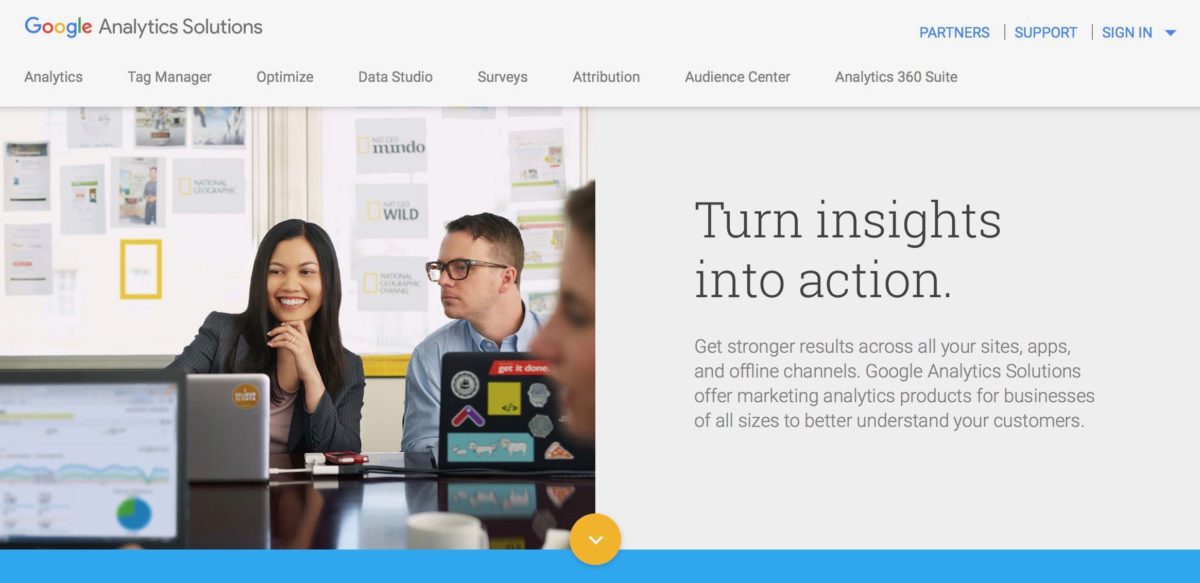How is your website performing? How many hits did you have last Tuesday? How many of those hits came from Michigan? What was your bounce rate? How long did the average user stay on a page? Those of you using Google Analytics can probably answer all of these questions in a matter of minutes with a simple glance at their dashboards.
Those who aren’t using Google Analytics … well, this post is for you.
Why Google Analytics?
In case you haven’t noticed, Google has the biggest market share where search engines are concerned. With 1.6 billion (yes, that’s billion with a B!) unique monthly visitors, it consistently resides in the top spot, followed very, very distantly by Bing, which has a mere 400 million visitors each month.
More than 72% of the world uses Google — and Google Analytics has the potential to tell you anything you want to know about all of them.
With Google Analytics, you’ll be able to see how many visitors your small business website had in a month, which and how many pages they visited, how long they stayed on each page, how long they stayed in your site and much, much more.
Are you sold yet? Good. Let’s get started.
Getting Started
All you need to get started with Google Analytics is a Gmail address. If you don’t have one, make one. It’s free, and it only takes a minute. This Gmail address should be private and something you plan on keeping forever, because once you link it to Google Analytics, there’s no way to change it — meaning if it disappears, so does all your historic data. (This is undesirable for obvious reasons.)
Ready? Great. Go here and sign up. You can choose to track a website or a mobile app. You’ll create an account name, add your website name and then answer a few basic questions regarding your industry category and time zone. You’ll also have the opportunity to opt into some data sharing permissions so Google can help you better. (These are all recommended, but what you share is completely up to you!)
Agree to the terms and conditions and Google Analytics will give you a tracking ID.
Important: This tracking ID must be installed on every single page you want to get data from!
Not sure how to install the ID? A quick Google search can give you plenty of resources. For instance, if you have a WordPress site, you’d search “how to install Google Analytics on WordPress.”
Once you have your desired pages tracked, it can take some time to start getting data — anywhere from a couple hours to a day or more. But once that data starts rolling in, you’ll be glad you waited!
Start Tracking!
Google Analytics allows you to track just about anything, from the demographics of your visitors to how fast your web page loads. And the more you use these tools, the easier it will be to add more metrics to your arsenal. But if you’re just starting out, you’ll want to keep it simple until you get the hang of things.
These are our recommendations for beginners:
Learn What People Are Searching For: The site search function allows you to see exactly what your visitors are entering into your search bar.
Set Goals: Goals alert you when certain activities happen on your site so you can take action. For instance, when a visitor subscribes to your newsletter or downloads your white paper, the goal you have set can trigger a thank you page, a follow-up video or even generate a special offer.
New/Returning Visitors: A pie chart on your dashboard will show you how many new visitors you have, as well as how many people have visited before.
Average Session Duration: How long are people staying on your site once they arrive? If this number is low, it means you need to step up your website game!
Compare: This will show you how you’re doing today compared to how you were doing on a date you select in the past.
Bounce Rate: How many people “bounce” off your site without leaving your landing page? A low bounce rate means you’re grabbing their attention. A high bounce rate means you’re not getting your message across in time.
These are only a few of the many features Google Analytics offers. If you dig down deeper, you’ll be able to see what language your users speak, their average screen resolution (helpful when determining whether you need a mobile site), what their interests are, your conversion rates and much more!
Google Analytics is a must for any small business owner, and although it can seem overwhelming when you’re just starting out, it’s far more user-friendly than it looks!
Need some help crunching the numbers or figuring out what they mean? Get in touch! Mischa Communications can decode your mysteries and give you concrete steps to a better small business website!
